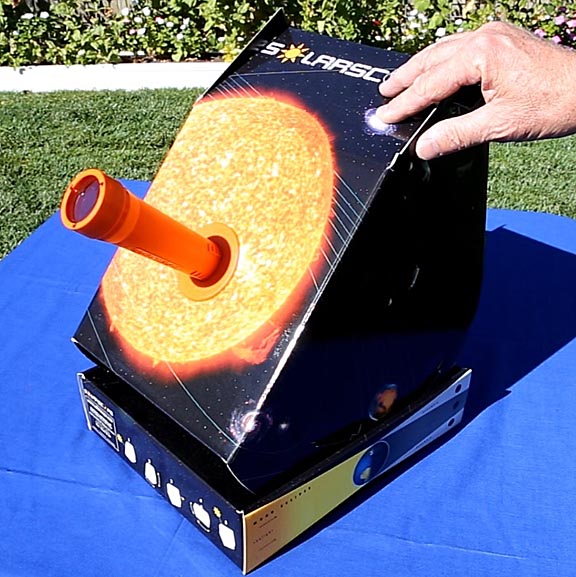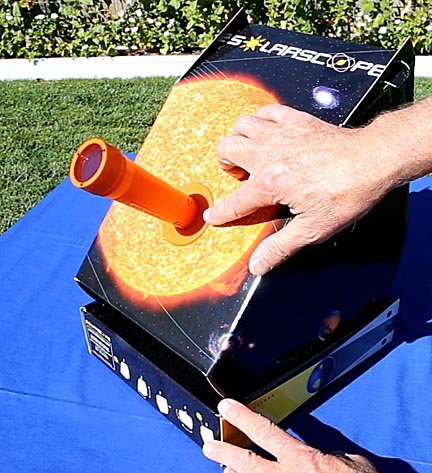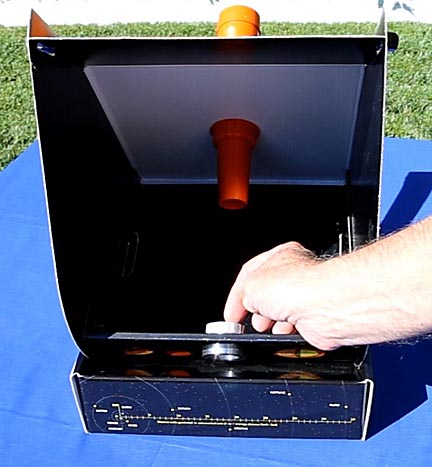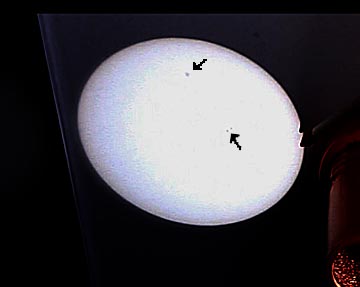


Having an easy-to-use instrument for viewing sun spots can be both educational and a lot of fun. The problem with most of the devices available is that they can be expensive. Telescope based viewers can run over $1,000. There is a cheaper sun spot viewing device called the Sunspotter, but even it's $500. Pin-hole projectors work, but even large versions produce painfully small images that are so small little detail can be seen. At $150 the Solarscope pictured above is a bargain, produces nice large images and is small enough for easy storage. The question is: Does it work? This review will provide the information you need to decide that for yourself.
The Solarscope consists of a heavy cardboard fold-together base and telescope body that fit together in an alt-azimuth mount system that is easy to align toward the sun. I found the assembly frustrating because the line drawings in the instructions didn't match the fold lines on the cardboard. In the end, looking at the finished pictures and examining how the cardboard was cut helped more than the instructions. The orange plastic lens holder went together easily, but again the directions and drawings weren't as clear as I'd hoped. The hardest unit to assemble was the aluminum holder/focuser for the tiny convex mirror that projects the sun's image created by the lens onto the viewing surface inside the Solarscope. It was almost impossible when to tell when the mirror was in the correct convex-surface-facing-outward position because of reflections off the shiny aluminum holder. Worse still, there was enough play between the mirror and the holder that it was easy to get it lodged at an angle. Once I managed to get it seated properly, I discovered the black rubber plug used to lock the mirror in place was so hard to push in that I had to use a wood dowel to get it to seat properly against the mirror. The first time I did it I discovered the mirror was crooked. But now the rubber plug was so firmly stuck it couldn't be removed. I ended up having to cut the plug almost in half and then use needle nosed pliers to pull it out so I could start all over. Making matters even worse is that the mirror is very tiny and it's necessary to keep the surface free of fingerprints, both of which make handling it a challenge.
Once these problems are overcome, using the Solarscope turned out to be easy.

Unless you want to lay on the ground to view the sun, it's necessary to place the Solarscope on a high table. Move the base left and right and the scope up and down until the shadow created by the end of the lens holder is concentric with the base of the lens holder. This will put the scope pointed almost directly at the sun.

Next, walk around to the rear of the Solarscope and look at the face of the mirror holder. There should be a bright spot of light focused on it. This is the image of the sun, which needs to strike the convex mirror to be projected up unto the white viewing surface inside the scope. Move the base and scope so that this bright spot hits the mirror and a 3.75-inch diameter disc of the sun should appear on the inside surface. Move the orange lens holder in or out for a rough focus, then the turn the threaded mirror holder in or out to fine focus. Once this is done, the Solarscope shouldn't need to be refocused again. The Earth-sun distance is so nearly constant that unless someone plays with the two focusing adjustments the Solarscope won't need refocusing.
Here's what you'll see:

The contrast, brightness and focus have been adjusted in this image to show what you'll see when looking at sunspots through the Solarscope. The upper arrow points to a sun spot about three times the diameter of the Earth. The lower two are each about the same size as the Earth. The disk is very bright so wearing sunglasses is a good idea.
Sun spots will appear as small fuzzy gray areas. The scope's resolution and contrast are too weak to produced sharply detailed sun spots. Occultations, such as when Venus passes across the face of the sun, appear sharper, but don't happen very often.
Solar images appear oblong because the focal plane is spherical while the surface on which the image is projected is flat. I made a spherical insert that matched the focal plane by moulding Fast Mache' (a powdered, paper mache' compound from Michael's Craft Stores) over a 16-inch diameter ball. It improved image quality a little but not enough to justify the work.
The Solarscope is the cheapest sun spot viewing device commercially available. Once it's assembled it should last for years with no more care than making sure it doesn't get wet or sat upon. It's quick and easy to use and I find it interesting to check for sun spots every few days. It's small enough to store on most closet shelves. The Solarscope comes is four sizes. The one I purchased is the smallest and cheapest, but they all work using the same design.
I testing it
on my six grandchildren ages 8 to 14 and while they all found it
interesting, their interest lasted only one quick look. This may have
been because there weren't many sun spots to look at but I suspect
it's too bland an experience to hold the attention of today's youths.
I found having to look in the direction of the sun to view the image to be a problem. Unless you push your face almost into the scope's body, glare from the sun is uncomfortable. Where small children are present, there is also the danger that they might not resist the urge to look up over the edge of the Solarscope directly at the sun.
My final review is that the poor assembly instructions, inconvenient viewing angle, soft distorted images and glare from looking toward the sun to use it make the Solarscope a poor choice. I felt I was getting $50 worth of image for $150. I hope to obtain the more expensive but better designed Sunspotter scope and compare how the two perform.
If you'd like to view a live action version of this review, please click on the following link:
Return to my main page to browse 60 other subjects